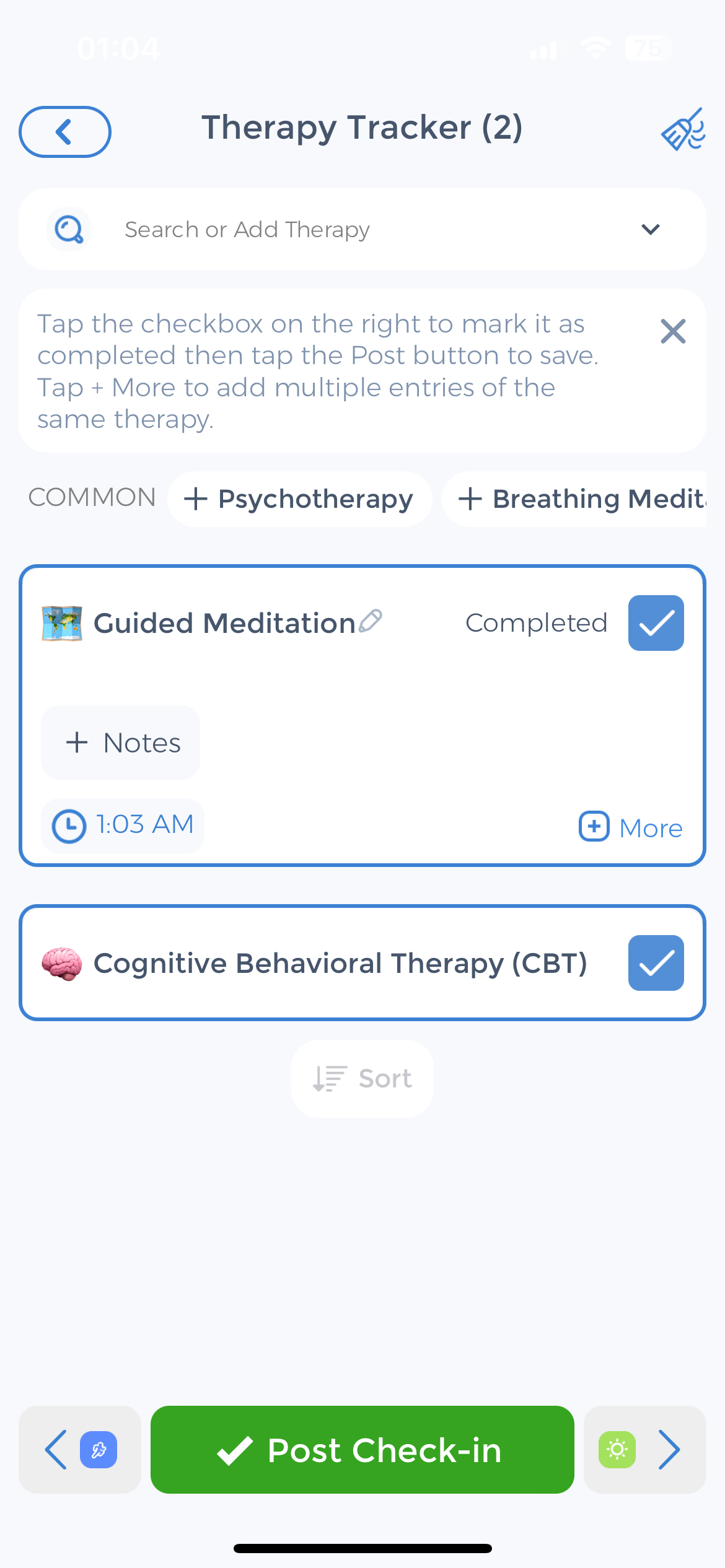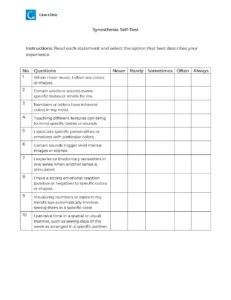
Welcome to the ultimate synesthesia test: a journey to discovering your unique perception. In this article, we will explore the fascinating world of synesthesia, delve into the science behind it, and provide you with insights on living with this extraordinary condition. So, let’s get started![1][2][3][4]
Printable Synesthesia Tests
⬇️ Synesthesia Battery Test PDF Printable[5][6]
Understanding Synesthesia: A Brief Overview
Synesthesia is a fascinating neurological phenomenon that blurs the lines between our senses. Allowing individuals to experience one sense in relate to another. This extraordinary condition is estimated to affect approximately 1 person in 2,000 people. Showcasing the diversity of human perception and cognition.
Individuals with synesthesia often possess a characteristics of heightened sensory experience. Where one stimulus can trigger a secondary perception in a different sensory pathway. This unique cross-wiring of the brain leads to a rich tapestry of sensations and feelings that are not commonly experienced by the general population.
What is Synesthesia?
Synesthesia is a condition characterized by the involuntary association between different sensory pathways in the brain. For instance, a synesthete may perceive colors when they hear music, smell or taste specific flavors when they encounter certain words. This blending of senses results in a truly individualized and often surreal perceptual encounter for each synesthete.
The intricate interplay between sensory modalities in synesthesia highlights the complexity and flexibility of the human brain in processing information. This condition frequently challenges traditional notions of perception and offers a glimpse into the remarkable diversity of human sensory perception.
Common Types of Diagnose Synesthesia
Synesthesia manifests in a myriad of forms, each involving unique combinations of senses and stimuli.
Some of the most common types of synesthesia include:
- Grapheme-color synesthesia: where letters or numbers are associated with specific colors. Creating a colorful alphabet and numerical system in the mind.
- Sound-color synesthesia: which elicits the perception of vivid colors in response to auditory stimuli. Transforming sound into a visual symphony.
- Number-form synesthesia: a phenomenon where numbers or sequences are visualized in distinct spatial arrangements. Showcasing the spatial nature of numerical cognition.
- Taste-color synesthesia: wherein tastes are experienced as different colors. Blending the realms of gustatory and visual sensations in a harmonious fusion.
The Science Behind Synesthesia
Understanding the science behind synesthesia requires a deeper exploration of the brain and genetic factors.
Synesthesia, a fascinating neurological phenomenon, has intrigued scientists and researchers for decades. This condition, where stimulation of one sensory pathway leads to automatic, involuntary experiences in a second sensory pathway, sheds light on the complex workings of the human brain.
The Brain and Synesthesia
Researcher suggests that synesthesia can relate to hyperconnectivity in the brain, specifically in the areas responsible for sensory processing. The phenomenon occurs when the cross-wiring between these areas allows different senses to interact in a way that is not typical for most individuals.
The brain’s plasticity and ability to rewire itself play a crucial role in synesthesia. Studies have shown that individuals with synesthesia have unique neural connections that enable them to experience the world in a multisensory way. This heightened connectivity between brain regions offers a glimpse into the remarkable adaptability of the human brain.
Genetic Factors in Synesthesia
Studies have also shown a genetic component to synesthesia, meaning it can run in families. Certain genes that relate to brain development and connectivity have been identified as potential contributors to this condition. Further research is underway to better understand the intricate genetic mechanisms involved.
The interplay between genetic predisposition and environmental influences in synesthesia is a topic of ongoing investigation. Researchers are delving into the intricate dance of nature and nurture to unravel the mysteries of how certain individuals inherit this unique perceptual condition.
The Ultimate Synesthesia Test
To truly grasp the intricacies of your synesthesia disorder, undergoing a comprehensive synesthesia test is crucial.
Synesthesia is a fascinating neurological phenomenon where the stimulation of one sense triggers an automatic, involuntary experience in another sense. This test is a window into the kaleidoscopic world of synesthetic perceptions, offering a glimpse into the extraordinary ways in which your senses intertwine and overlap.
What to Expect from the Test
The synesthesia test is a quiz designed to measure your unique perceptual experiences across multiple senses. Through a series of carefully crafted stimuli, the test aims to identify the specific synesthetic associations you may have.
During the test, you may encounter a variety of stimuli such as visual patterns, auditory tones, or even gustatory sensations that could evoke unexpected responses in your other senses. Each response provides valuable insight into the intricate web of connections that shape experience synesthesia.
Interpreting Your Test Results
Once you decide you have answer and completed the synesthesia test, interpreting the test results may require some guidance. The test will provide insights into the other types of synesthesia you experience and how your senses interact. Understanding your results can help you embrace your synesthetic gifts and navigate everyday situations with a newfound appreciation for your unique perception.
Delving into the nuances of your synesthetic responses can open up a world of self-discovery and appreciation for the richness of your sensory experiences. Embrace the quirks and beauty of your synesthetic perceptions, for they offer a glimpse into a heightened realm of sensory interconnectedness that is truly extraordinary.
Living with Synesthesia
Living with synesthesia brings both benefits and challenges. Let’s explore these in more detail.
Synesthesia is a fascinating neurological phenomenon where the stimulation of one sensory pathway leads to automatic, involuntary experiences in another sensory pathway. This unique condition can manifest in various forms, such as seeing color consistency when hearing music or associating specific tastes with certain sounds or words. Individuals with synesthesia often describe their sensory perceptions as vivid and intertwined, creating a rich tapestry of experiences that differ from the typical human sensory experience.
The Benefits of Synesthesia
- Enhanced creativity: Most synesthetes often have a heightened ability to make creative connections between different senses, leading to innovative artistic expression.
- Memorable experiences: The synesthetic perceptions add depth and richness to everyday experiences, making them more memorable and vibrant.
- Enhanced cognitive abilities: Some studies suggest that synesthetes have enhanced memory and cognitive flexibility.
Moreover, synesthesia has been linked to increased empathy and emotional understanding. The ability to perceive the world through multiple senses can cultivate a deeper sense of empathy towards others, for example, as synesthetes are accustomed to experiencing the world in a uniquely interconnected way.
Challenges and Misconceptions: Synesthesia Research
While synesthesia can be enriching, it does come with its challenges. The blending of sensations can sometimes be overwhelming, leading to sensory overload. Additionally, there are common misconceptions surrounding synesthesia that can lead to misunderstanding and lack of support. Educating others about synesthesia and advocating for understanding can help address these challenges.
Furthermore, navigating a world designed for the typical sensory experience can present daily hurdles for individuals with synesthesia. Simple tasks like reading a menu or listening to music can become complex when sensory perceptions overlap, requiring additional mental processing and concentration. Despite these challenges, many synesthetes view their condition as a unique and integral part of their identity, shaping how they can be perceiving and interact with the world around them.
Enhancing Your Perception: Tips for Synesthetes
Harnessing Your Synesthesia for Creativity
 If you are a synesthete looking to enhance your creativity, consider these strategies:
If you are a synesthete looking to enhance your creativity, consider these strategies:
- Experiment with different combinations of sensory stimuli to explore new synesthetic experiences.
- Embrace your unique perspective and use it as a source of inspiration for artistic endeavors.
- Connect with other synesthetes to share experiences and gain insights into how others harness their synesthesia for creativity.
One fascinating aspect of synesthesia is how it can be harnessed as a powerful tool for creativity. By exploring the interconnected nature of your senses, you can unlock a world of inspiration that transcends traditional boundaries. Imagine the possibilities of tasting specific color, hearing words or textures, or seeing music – each experience offering a unique perspective that can fuel your creative endeavors in ways you never thought possible.
Coping Strategies for Overwhelming Sensory Input
 To manage overwhelming synesthetic sensations, try these coping strategies:
To manage overwhelming synesthetic sensations, try these coping strategies:
- Practice mindfulness and relaxation techniques to calm your mind and focus on specific sensory inputs.
- Create a sensory-friendly environment by controlling stimuli, such as lighting and sound levels.
- Seek support from healthcare professionals, synesthesia communities, and online resources to learn from others’ experiences.
While synesthesia can be a source of inspiration, it can also present challenges when sensory inputs become overwhelming. By practicing mindfulness and creating a calming environment, you can navigate these intense experiences with greater ease. Remember, you are not alone in your journey. Reaching out to others who share similar experiences can provide valuable insights and support as you navigate the complexities of synesthesia.
Now that you have gained a deeper understanding of synesthesia and its complexities, take the synesthesia test or synesthesia battery to unlock the mysteries of your perception. Embrace your synesthetic experiences and use them as a source of inspiration and self-discovery on your unique journey. Remember, you have a remarkable ability to perceive things and the world in ways others can only imagine.
Use the CareClinic App to Take Note of Synaesthesia Scenarios
Discover a new way to manage your synesthetic experiences with the CareClinic App. By tracking your sensory inputs and reactions, you can gain insights into patterns and triggers, helping you to better understand and manage your synesthesia.
The app’s diary and mood tracking features allow you to document your multisensory experiences and their impact on your daily life. This personalized data can be invaluable in creating coping strategies that work for you.
Download the CareClinic App for Consistent Tracking of Synaesthesia
With the CareClinic App, you can also set reminders for mindfulness exercises or environmental adjustments, ensuring you maintain a sensory-friendly space. The app’s comprehensive health dashboard provides a holistic view of your well-being, integrating your synesthetic experiences with other health metrics. By using CareClinic to monitor your unique perception, you’re taking a proactive step towards improved health outcomes. Install App today and start your journey to better synesthesia management.
References
- “Synesthesia | Psychology Today”. https://www.psychologytoday.com/us/basics/synesthesia
- “Grapheme–color synesthesia”. https://en.wikipedia.org/wiki/Grapheme%E2%80%93color_synesthesia
- “Synesthesia's mysterious ‘mingling of the senses' may result from hyperconnected neurons | Science | AAAS”. https://www.science.org/content/article/synesthesia-s-mysterious-mingling-senses-may-result-hyperconnected-neurons
- “Synesthesia Battery | Pre-test”. https://synesthete.org/pretest
- “Synesthesia Battery | Home”. https://www.bnc.bcm.edu/home
- “Links and downloads : Synaesthesia research : University of Sussex”. https://www.sussex.ac.uk/synaesthesia/links
- “Synesthesia”. https://en.wikipedia.org/wiki/Synesthesia
- “Chromesthesia”. https://en.wikipedia.org/wiki/Chromesthesia
- “A whole-genome scan and fine-mapping linkage study of auditory-visual synesthesia reveals evidence of linkage to chromosomes 2q24, 5q33, 6p12, and 12p12 – PubMed”. https://pubmed.ncbi.nlm.nih.gov/19200526/
- “Unlocking the Genetic Basis of Synesthesia : Neurology Today”. https://journals.lww.com/neurotodayonline/Fulltext/2018/04190/Unlocking_the_Genetic_Basis_of_Synesthesia.3.aspx



